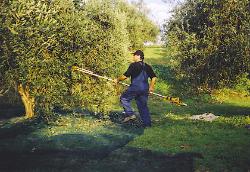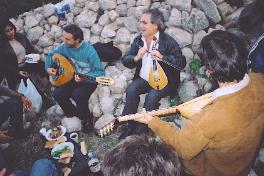| Crete's Culinary Sanctuaries Seasonal Activities |

Crete's long hot summers and mild winters produce intense flavor in the wide variety of
fruits and vegetables grown on the island. The vibrant colors of the sea and sky may
enhance the flavor of your meze in Crete, but the produce really does play a starring role.
The downside for farmers is the lack of rainfall and the price of water. Harvest and
production times vary according to Mother Nature, especially for the olive harvest, which
takes place once the rainy season is underway and the olives have developed the desired
plumpness and color for the individual producer’s tastes. Depending on winter rainfall,
wind speed, dust storms from Africa, and unpredictable heat waves in March, the chart
below is a general guideline.
Each season in Crete offers something special. Highlights are:
Winter (December – February): Olive harvest and raki making.
An exciting time of year from an agricultural production standpoint that also coincides with
numerous winter festivals. Many villages still have a community olive oil factory – some are
traditional and some are modern.
Culinary Highlights: Pork chops or the thick bacon-cut grilled in a rack over the indoor
fireplace, braised meats or cuttlefish, roasted chicken and potatoes, avgolemeno soup,
vegetable and legume stews, gorgeous roasted chestnuts, cabbage salad. Aged cheese,
dakos bread and lots of olives.
Spring (March – May): Easter, lamb on the spit, cheese making, treks in the countryside
to collect edible wild plants and herbs. Once the rains subside, the countryside is
kaleidoscopic blur of colors: red poppies, purple irises and thistles, yellow sage,
dandelions and chamomile.
Culinary Highlights: Lamb, fresh sheep's milk cheese curd (malakos), fresh soft cheese
(mizithra), thick, rich yogurt with wild-thyme honey, subtle fish stews, horta (braised wild
greens), marouli (lettuce with spring onions and dill), zucchini braised with tomatoes, spring
onions and garlic, dolmades with zucchini flowers or grape leaves, snails made a million
ways.
Summer (June – September): Summer is the time to savor Crete's vast array of local
fruits and vegetables. Activities include beekeeping, the grape harvest and winemaking
(late summer), swimming and spear fishing.
Culinary Highlights: Steamed mussels -- no frills, eaten with a splash of lemon (See:
Zambia article), grilled fish and octopus, smelts, sole and other small fish fried in olive oil,
grilled meats, steamed beets, roasted red peppers, eggplant (grilled, fried or pureed),
gorgeous heirloom tomatoes, wax peppers, cucumbers, watermelon, figs, apricots, grapes.
Fall (October – November): Raki making festivals, relaxing and preparing for the
harvest season. The rainy season slowly begins with dramatic thunderstorms, nourishing
the parched earth and softening the stark summer skies.
Culinary Highlights: Heavenly fresh seafood soups, roasted chicken or pork with
potatoes, fall vegetable and bean stews, ember-baked potatoes, pomegranates, pears,
almonds, walnuts, peanuts.
If you have any questions, just ask. Reserve Your Space Today
fruits and vegetables grown on the island. The vibrant colors of the sea and sky may
enhance the flavor of your meze in Crete, but the produce really does play a starring role.
The downside for farmers is the lack of rainfall and the price of water. Harvest and
production times vary according to Mother Nature, especially for the olive harvest, which
takes place once the rainy season is underway and the olives have developed the desired
plumpness and color for the individual producer’s tastes. Depending on winter rainfall,
wind speed, dust storms from Africa, and unpredictable heat waves in March, the chart
below is a general guideline.
Each season in Crete offers something special. Highlights are:
Winter (December – February): Olive harvest and raki making.
An exciting time of year from an agricultural production standpoint that also coincides with
numerous winter festivals. Many villages still have a community olive oil factory – some are
traditional and some are modern.
Culinary Highlights: Pork chops or the thick bacon-cut grilled in a rack over the indoor
fireplace, braised meats or cuttlefish, roasted chicken and potatoes, avgolemeno soup,
vegetable and legume stews, gorgeous roasted chestnuts, cabbage salad. Aged cheese,
dakos bread and lots of olives.
Spring (March – May): Easter, lamb on the spit, cheese making, treks in the countryside
to collect edible wild plants and herbs. Once the rains subside, the countryside is
kaleidoscopic blur of colors: red poppies, purple irises and thistles, yellow sage,
dandelions and chamomile.
Culinary Highlights: Lamb, fresh sheep's milk cheese curd (malakos), fresh soft cheese
(mizithra), thick, rich yogurt with wild-thyme honey, subtle fish stews, horta (braised wild
greens), marouli (lettuce with spring onions and dill), zucchini braised with tomatoes, spring
onions and garlic, dolmades with zucchini flowers or grape leaves, snails made a million
ways.
Summer (June – September): Summer is the time to savor Crete's vast array of local
fruits and vegetables. Activities include beekeeping, the grape harvest and winemaking
(late summer), swimming and spear fishing.
Culinary Highlights: Steamed mussels -- no frills, eaten with a splash of lemon (See:
Zambia article), grilled fish and octopus, smelts, sole and other small fish fried in olive oil,
grilled meats, steamed beets, roasted red peppers, eggplant (grilled, fried or pureed),
gorgeous heirloom tomatoes, wax peppers, cucumbers, watermelon, figs, apricots, grapes.
Fall (October – November): Raki making festivals, relaxing and preparing for the
harvest season. The rainy season slowly begins with dramatic thunderstorms, nourishing
the parched earth and softening the stark summer skies.
Culinary Highlights: Heavenly fresh seafood soups, roasted chicken or pork with
potatoes, fall vegetable and bean stews, ember-baked potatoes, pomegranates, pears,
almonds, walnuts, peanuts.
If you have any questions, just ask. Reserve Your Space Today

